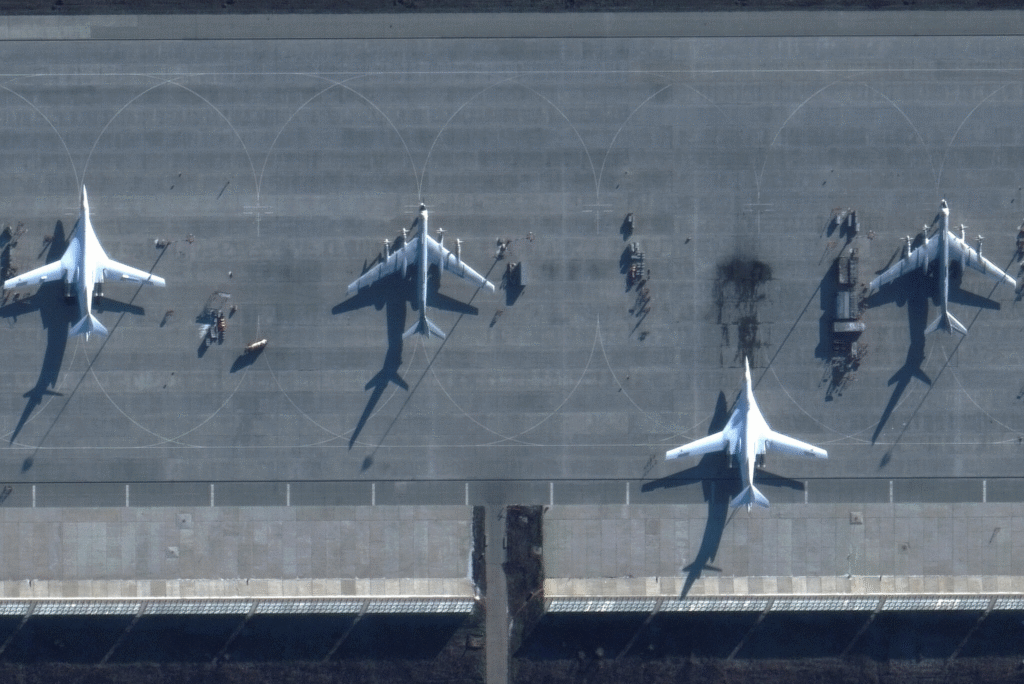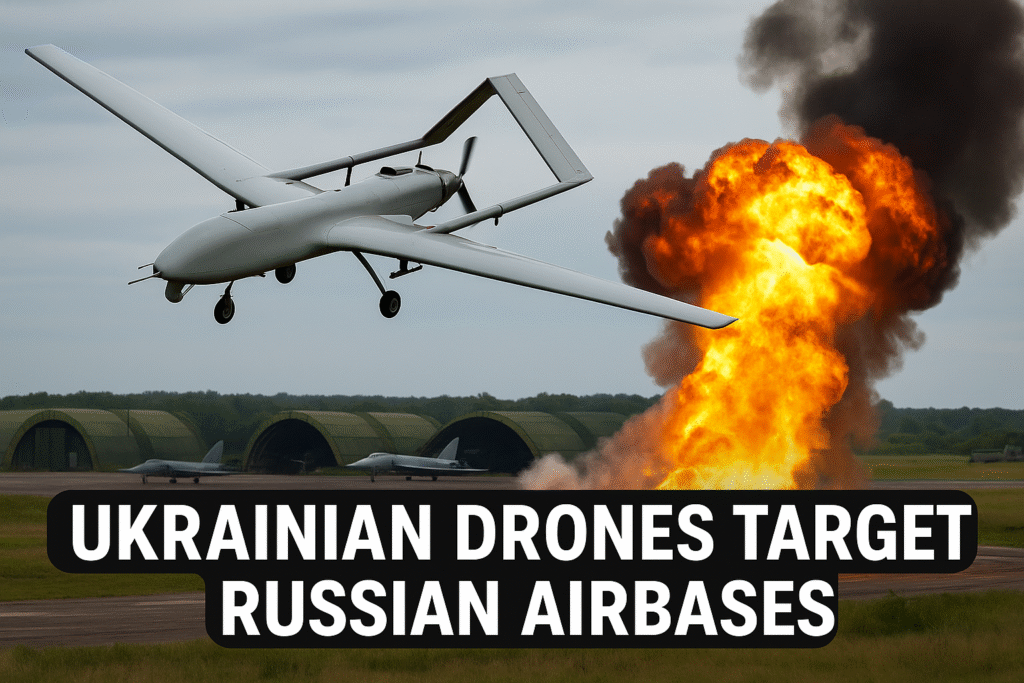
In a bold escalation of its military strategy, Ukraine has launched a series of drone strikes targeting Russian airbases in an operation that has sent shockwaves through international circles. This unprecedented move signals a significant shift in Ukraine’s approach to countering Russian aggression and showcases its growing capability to strike deep into enemy territory.
The early morning operation, carried out on June 1, involved the deployment of advanced unmanned aerial systems (UAS) aimed at key airbases in Russia. The Ukrainian military’s General Staff confirmed that several drones successfully hit their targets, causing substantial damage to infrastructure and reportedly incapacitating aircraft used in Moscow’s war efforts. As the world watches closely, this development marks a pivotal moment in the ongoing conflict.
The Mechanics of the Operation
Details emerging from Ukrainian military sources reveal a meticulously planned operation executed with precision. The drones, reportedly equipped with advanced targeting systems and explosive payloads, were launched from undisclosed locations. They navigated hundreds of kilometers into Russian airspace, bypassing sophisticated air defense systems. Military analysts have noted that the ability to penetrate such defenses is a testament to Ukraine’s technological advancements and innovative tactics.
The airbases targeted in this operation are strategically significant to Russia’s ongoing campaigns in Ukraine. These sites house critical assets, including bombers and fighter jets that have been integral to Russian aerial dominance. Ukrainian officials emphasized that these strikes were not aimed at civilian areas but strictly at military facilities, adhering to international humanitarian laws.
Russian Response and Global Implications
The Kremlin’s reaction to the strikes was swift and predictably forceful. Russian defense officials claimed to have intercepted several drones, although independent verification suggests that some attacks successfully breached their defenses. Moscow labeled the strikes as acts of aggression and vowed retaliatory measures, raising concerns about potential escalation in the region.
International reactions have been mixed. NATO and Western allies have refrained from outright endorsement of the operation but have reiterated their support for Ukraine’s sovereignty and right to self-defense. The strikes have also drawn attention to the evolving nature of modern warfare, where drones play a pivotal role in reshaping battlefield dynamics.
Ukraine’s Strategic Shift: From Defense to Offense
Ukraine’s use of drones to target Russian airbases underscores a broader shift in its military strategy. Since the onset of the conflict, Kyiv has primarily focused on defensive measures, repelling Russian advances and protecting key cities. However, this latest operation indicates a transition towards an offensive posture aimed at disrupting Russian military capabilities.
Military experts have highlighted the psychological impact of such strikes. By targeting airbases deep within Russia, Ukraine sends a clear message of resilience and determination. These actions also serve to erode the perception of invulnerability that Russian military installations once enjoyed.
The Role of Technology and Western Support
Central to Ukraine’s evolving military capabilities is the role of technology and international support. The drones used in the operation are believed to be a mix of domestically developed systems and advanced models supplied by Western allies. This collaboration has enabled Ukraine to enhance its operational reach and precision.
Furthermore, the strikes underscore the importance of intelligence sharing between Ukraine and its partners. Real-time data on Russian troop movements and infrastructure has been instrumental in planning and executing such operations. Western nations, particularly the United States and the United Kingdom, have played a crucial role in providing this support.
Escalation Risks and Diplomatic Repercussions
While the operation demonstrates Ukraine’s growing military competence, it also raises questions about the risks of escalation. Russia’s retaliation could lead to further intensification of the conflict, with broader implications for regional stability. The potential for civilian casualties and collateral damage in future strikes also remains a concern.
Diplomatically, the strikes could complicate ongoing efforts to mediate a resolution to the conflict. While Ukraine’s allies continue to back its right to defend its sovereignty, there is cautious apprehension about the potential consequences of such aggressive tactics. The international community is likely to face increased pressure to broker a ceasefire or facilitate dialogue between the warring nations.
Historical Context: Ukraine’s Journey Towards Self-Defense
To fully understand the significance of these strikes, one must consider the historical context of Ukraine’s defense strategy. Since gaining independence in 1991, Ukraine has faced numerous security challenges, culminating in Russia’s annexation of Crimea in 2014 and the subsequent invasion in 2022. These events have galvanized Ukraine’s efforts to modernize its military and adopt a more proactive defense posture.
Over the years, Ukraine has transitioned from relying on Soviet-era equipment to developing a robust defense industry capable of producing advanced weaponry. This transformation has been accelerated by substantial foreign aid and training programs, enabling the country to counter Russian aggression more effectively.
The Human Element: Voices from the Frontlines
Beyond the technological and strategic dimensions, the success of such operations is a testament to the dedication and bravery of Ukrainian forces. Soldiers and operators involved in these missions have demonstrated exceptional skill and resilience, often under challenging conditions.
Reports from the frontlines reveal a deep sense of purpose among Ukrainian personnel. Many see their efforts as part of a larger struggle for national survival and the preservation of democratic values. Their stories underscore the human cost of war and the enduring spirit of those defending their homeland.
The Ripple Effect: Impact on Regional Security
The implications of Ukraine’s drone strikes extend beyond the immediate conflict. Neighboring countries are closely monitoring developments, aware that the balance of power in Eastern Europe could shift dramatically. Nations like Poland and the Baltic states have expressed solidarity with Ukraine, while also bolstering their own defenses against potential aggression.
Russia’s neighbors are acutely aware of the potential spillover effects of the conflict. As Ukraine demonstrates its ability to strike within Russian borders, the strategic calculus for surrounding nations becomes increasingly complex. This evolving situation underscores the interconnected nature of modern security dynamics.
Global Lessons from Ukraine’s Drone Strategy
Ukraine’s use of drones to target Russian airbases provides valuable lessons for militaries worldwide. The operation highlights the potential of unmanned systems to reshape modern warfare, offering cost-effective and precise alternatives to traditional methods. As other nations observe Ukraine’s tactics, there is likely to be increased investment in drone technology and counter-drone measures.
However, this trend also raises ethical and legal questions. The proliferation of drone technology could lead to its misuse by non-state actors or rogue regimes. The international community must address these challenges by establishing clear norms and regulations governing the use of unmanned systems in warfare.
The Role of Propaganda and Information Warfare
As the conflict unfolds, information warfare continues to play a critical role. Both Ukraine and Russia have utilized propaganda to shape international perceptions and galvanize domestic support. The recent drone strikes have been no exception, with both sides releasing competing narratives to influence global opinion.
Ukraine has framed the operation as a necessary step to protect its sovereignty and deter further aggression. Meanwhile, Russian state media has portrayed the strikes as reckless acts of provocation, aimed at undermining regional stability. This battle for narrative control underscores the multifaceted nature of modern conflicts, where the fight extends beyond the battlefield.
Looking Ahead: The Future of the Conflict
As Ukraine continues to push the boundaries of its military capabilities, the conflict shows no signs of abating. The recent drone strikes on Russian airbases mark a significant milestone, but they also underscore the complexities of the ongoing war. Both sides remain entrenched, with little indication of a near-term resolution.
For Ukraine, the operation serves as a powerful statement of intent. It demonstrates the country’s ability to adapt and innovate in the face of adversity. At the same time, it underscores the need for continued support from the international community to sustain its efforts.
Strategic Partnerships: Strengthening Alliances
Ukraine’s ability to carry out such operations is a testament to the strength of its alliances. The country has relied heavily on the support of NATO and Western partners, who have provided critical resources, intelligence, and training. These partnerships have not only bolstered Ukraine’s military capabilities but also reinforced its position on the global stage.
The importance of international alliances cannot be overstated. As Ukraine navigates the challenges of the conflict, the backing of its allies will be crucial in ensuring its long-term security and stability. This support must extend beyond military aid to include economic assistance, reconstruction efforts, and diplomatic advocacy.
In conclusion, the June 1 drone strikes represent a watershed moment in Ukraine’s conflict with Russia. As the world watches closely, the operation’s implications will undoubtedly shape the trajectory of the war and influence global military strategies for years to come. The evolving dynamics of this conflict serve as a stark reminder of the complexities and human cost of war, underscoring the urgent need for a resolution that ensures lasting peace and security for the region.

